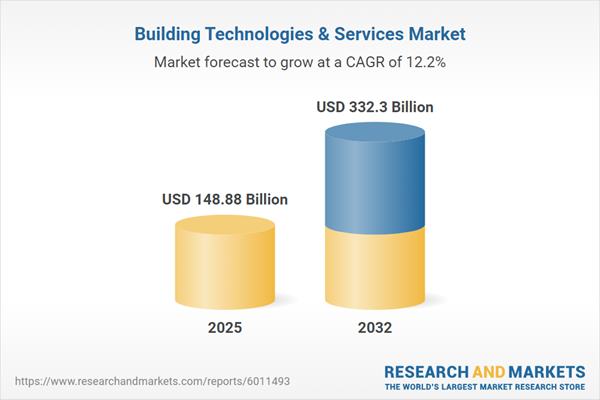Speak directly to the analyst to clarify any post sales queries you may have.
The building technologies and services market is rapidly evolving as organizations prioritize regulatory compliance, operational efficiency, and sustainable practices. Senior executives are seeking strategic solutions enabling reliable facility management, risk reduction, and alignment with evolving global standards.
Market Snapshot: Building Technologies & Services Market
In 2024, the global building technologies and services market reached a valuation of USD 132.38 billion and is projected to climb to USD 148.88 billion in 2025, with expectations to reach USD 332.30 billion by 2032. The market is advancing at a robust compound annual growth rate of 12.19%. Key drivers include expanding investment in digital infrastructure, adoption of advanced energy management systems, and increased focus on integrated facility management. Industry innovators are leveraging these capabilities to improve operational performance, address regulatory requirements, and scale up sustainability efforts.
Scope & Segmentation of the Building Technologies & Services Market
- Offering Types: Advanced security systems, fire safety equipment, HVAC solutions, installation and maintenance services, and software monitoring equip facilities to mitigate risk, safeguard assets, and ensure reliability.
- Application Models: Centralized, decentralized, and cloud-based frameworks facilitate seamless integration of sensors for climate control, surveillance, and automated access, supporting flexible operations.
- End Users: Commercial property managers, healthcare organizations, retailers, manufacturers, transport providers, utility operators, and residential communities utilize these technologies to meet compliance, risk, and efficiency needs across diverse environments.
- Deployment Modes: On-premise, private, public, and hybrid cloud options help organizations align with internal IT priorities, preserving resilience and regulatory compliance while reducing disruption.
- Connectivity Protocols: Wired solutions like Ethernet and fieldbus alongside wireless methods including Bluetooth, cellular, and Wi-Fi provide real-time data insights for distributed facility oversight.
- Regional Coverage: North and South America, Europe, Asia-Pacific, and other regions drive adoption based on their unique regulatory frameworks, infrastructure development, and focus on smart building investments.
- Leading Companies: Industry leaders such as Johnson Controls International, Siemens AG, Schneider Electric SE, Honeywell International, ABB Ltd, Emerson Electric, Carrier Global, Eaton Corporation, Mitsubishi Electric, and Robert Bosch GmbH deliver scalable solutions tailored to diverse facility demands.
Key Takeaways for Senior Decision-Makers
- AI-enabled and IoT-integrated platforms enable facilities to respond swiftly to evolving operational risks and adapt efficiently to infrastructure challenges.
- Deploying digital building solutions enhances compliance preparedness, helping organizations remain agile amid shifting regulatory environments at local and international levels.
- Embedding sustainability within facility practices and supply chains streamlines responsible sourcing and supports organization-wide compliance throughout building life cycles.
- Outcome-driven service models foster improved alignment between technology providers and customer business goals, strengthening asset reliability and long-term performance partnerships.
- Integrating modular, open-platform technology architectures supports scalable modernization, facilitating the management of both legacy and new facility assets.
- Regional strategies—such as prioritizing advanced security protocols in the Americas, analytics adoption in Europe, and rapid technology deployment across Asia-Pacific—enhance outcomes within specific markets.
2025 Tariff Impact on Global Supply Chains
Forthcoming US tariff changes are influencing organizations to reinforce supply chain resilience for building technologies. Increased local manufacturing, supplier diversification, and improved inventory practices are ensuring operational continuity and industry-wide collaboration, helping companies stay compliant and responsive to an evolving global trade context.
Research Methodology & Data Sources
This analysis is based on a combination of expert interviews, targeted online surveys, and in-depth reviews of current regulations and industry benchmarks. Recommendations are further validated through scenario workshops designed to reflect the strategic goals of building technology leaders.
Why This Report Matters
- Enables executives to drive digital transformation in line with regulatory compliance and rigorous risk management objectives.
- Provides practical insights to help fast-track sustainability initiatives and optimize performance across a broad range of facility types and organization sizes.
- Delivers actionable guidance supporting future-ready, sustainable growth and informed investment decisions across building technology portfolios.
Conclusion
Leveraging insights from this report, leaders can strengthen technology strategies, enhance organizational resilience, and drive sustainable progress in an evolving global environment.
Additional Product Information:
- Purchase of this report includes 1 year online access with quarterly updates.
- This report can be updated on request. Please contact our Customer Experience team using the Ask a Question widget on our website.
Table of Contents
3. Executive Summary
4. Market Overview
7. Cumulative Impact of Artificial Intelligence 2025
Companies Mentioned
The companies profiled in this Building Technologies & Services market report include:- Johnson Controls International plc
- Siemens AG
- Schneider Electric SE
- Honeywell International Inc.
- ABB Ltd
- Emerson Electric Co.
- Carrier Global Corporation
- Eaton Corporation plc
- Mitsubishi Electric Corporation
- Robert Bosch GmbH
Table Information
| Report Attribute | Details |
|---|---|
| No. of Pages | 183 |
| Published | October 2025 |
| Forecast Period | 2025 - 2032 |
| Estimated Market Value ( USD | $ 148.88 Billion |
| Forecasted Market Value ( USD | $ 332.3 Billion |
| Compound Annual Growth Rate | 12.1% |
| Regions Covered | Global |
| No. of Companies Mentioned | 11 |









